Getting this error on ALL ClickOnce application launches for a certain user. This started happening after a version upgrade (but happens to no one else).
I've tried subsequently changing the version number, add/remove, registry scrub, clearing Local Settings\Apps folder, etc... Still no luck.
This article points to a user profile corruption, but I recreating this user isn't an option. Are there any other ideas on cleaning this up?
PLATFORM VERSION INFO
Windows : 5.1.2600.196608 (Win32NT)
Common Language Runtime : 2.0.50727.3082
System.Deployment.dll : 2.0.50727.3053 (netfxsp.050727-3000)
mscorwks.dll : 2.0.50727.3082 (QFE.050727-3000)
dfdll.dll : 2.0.50727.3053 (netfxsp.050727-3000)
dfshim.dll : 2.0.50727.3053 (netfxsp.050727-3000)
SOURCES
Deployment url : file:///C:/Documents%20and%20Settings/<username>/Start%20Menu/Programs/<programname>/<programname>.appref-ms%7C
ERROR SUMMARY
Below is a summary of the errors, details of these errors are listed later in the log.
* Activation of \\NDP13\C\Documents and Settings\<username>\Start Menu\Programs\<programname>\<programname>.appref-ms| resulted in exception. Following failure messages were detected:
+ Value does not fall within the expected range.
COMPONENT STORE TRANSACTION FAILURE SUMMARY
No transaction error was detected.
WARNINGS
There were no warnings during this operation.
OPERATION PROGRESS STATUS
* [7/22/2009 10:35:30 AM] : Activation of \\NDP13\C\Documents and Settings\<username>\Start Menu\Programs\<programname>\<programname>.appref-ms| has started.
ERROR DETAILS
Following errors were detected during this operation.
* [7/22/2009 10:35:30 AM] System.ArgumentException
- Value does not fall within the expected range.
- Source: System.Deployment
- Stack trace:
at System.Deployment.Internal.Isolation.IsolationInterop.GetUserStore(UInt32 Flags, IntPtr hToken, Guid& riid)
at System.Deployment.Internal.Isolation.IsolationInterop.GetUserStore()
at System.Deployment.Application.ComponentStore..ctor(ComponentStoreType storeType, SubscriptionStore subStore)
at System.Deployment.Application.SubscriptionStore..ctor(String deployPath, String tempPath, ComponentStoreType storeType)
at System.Deployment.Application.SubscriptionStore.get_CurrentUser()
at System.Deployment.Application.ApplicationActivator.PerformDeploymentActivation(Uri activationUri, Boolean isShortcut, String textualSubId, String deploymentProviderUrlFromExtension, BrowserSettings browserSettings, String& errorPageUrl)
at System.Deployment.Application.ApplicationActivator.ActivateDeploymentWorker(Object state)
COMPONENT STORE TRANSACTION DETAILS
No transaction information is available.



